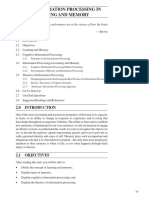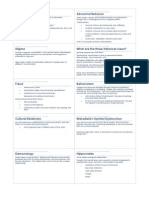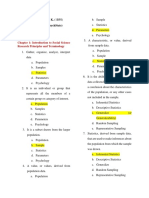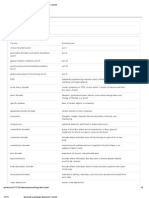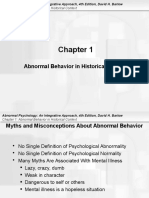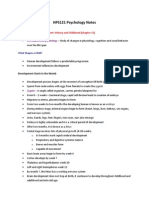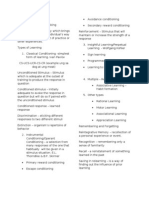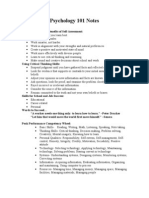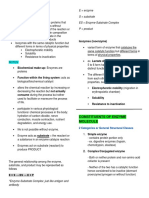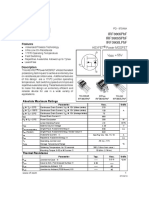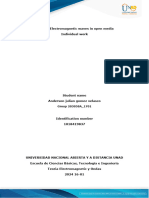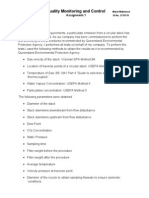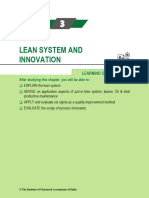Theories of Personality
Theories of Personality
Uploaded by
Cor VillanuevaCopyright:
Available Formats
Theories of Personality
Theories of Personality
Uploaded by
Cor VillanuevaOriginal Description:
Copyright
Available Formats
Share this document
Did you find this document useful?
Is this content inappropriate?
Copyright:
Available Formats
Theories of Personality
Theories of Personality
Uploaded by
Cor VillanuevaCopyright:
Available Formats
INTRO
________1. An unsubstantiated
hypothesis or a speculation
concerning a reality that is not yet
definitely known to be so.
________2. Power of theory to
arouse curiosity which generates
research by suggesting ideas or even
by arousing disbelief and resistance
________3. Refers to how applicable
a theory is
________4. The capacity of the
theory to generate predictions that
are confirmed when the relevant
empirical data are collected.
________5. Refers to the scope or
completeness of these derivations
________6. He extracted almost 50
different definitions of personality
________7. The individual is capable
of all of the processes or activities
such as his interests, abilities and
habits, processes and activities we
go through
________8. Every individual has
various characteristics that are
related to one another, mind is
connected to emotion and emotion
is connected to behavior
________. Personality is the sum
total of the various aspects of the
individual, we are more than our
name, intelligence and grade
________10. Distinctive way of
facing the ups and downs of life.
________11. The whole is more than
the sum
________12. No personality stays
the same
________13. Constant personality
________14. The process of
converting speculations about
human nature into concepts that
can be empirically studied, as
opposed to relying on intuition,
folklore, or common sense.
________15. Seeks to establish
better ways of understanding
persons through the use of various
research strategies.
________16. Represents the basic
building blocks of psychological life
________17. Accounts for why
people do the things they do
________18. Focuses on a stage
model that shows the patterns of
growth and change in a persons life
________19. Refers to the criteria by
which a healthy personality
________20. Refers to the causes of
maladaptive or pathological
(uncontrolled) styles of behavior
________21. Refers to ways of
achieving positive changes in
behavior
FREUD
________1. What is Freud known
for?
________2. Psychiatrist who
influenced Freud in using hypnosis
as treatment to hysteria
________3. Who devised the talkout treatment?
________4. What is the release and
freeing of emotion, repressed ideas
or experiences through talking about
ones problems?
________5. What is the foundation
of dynamics of psychological
functioning that studies the transfer
of heat in various physical &
chemical processes?
________6. Who is the physiologist
that influenced him?
________7. A fundamental principle
that is based on homeostasis a.k.a
sine qua non
________8. A fundamental principle
that states everything in life is
manifested in 2 dissimilar qualities
________9. A fundamental principle
that states a man as a habitfollowing animal; the longer he does
so the more fixed it becomes as his
mode of behavior in daily life.
________10. Refers to the more
stable and enduring aspects of
personality
________11. It is the result when an
emotion is blocked from expression
inducing a certain symptom as an
indirect expression.
________12. A conflict between a
drive or wish and the egos sense
________13. Personality structure
which represents basic needs, urges,
impulses
________13.1 It operates according
to the principle of avoiding pain and
gaining pleasure
________13.2 It motivates people to
focus on pleasure-seeking
tendencies
________13.3 It motivates people to
use aggressive urges to destroy
________14. Personality structure
which represents values, norms, and
morality
________15. Personality structure
that is executive and the decisionmaker, rational part of it
________15.1 Operates according to
the principle of satisfying Ids desire
in a method that is both socially
appropriate and realistic
________16. Level of consciousness
that is alogical, where dreams
appear and is outside of awareness
at all times
________16.1 Notions of
right/wrong
________16.2 How we ideally like to
be
________17. Level of consciousness
where memories are stored
________18. Level of consciousness
of a persons current state of
awareness
________19. Stages of personality
development that occurs in every
childs life
________20. Being stuck in a stage
________21. Part of the body that
involve sexual pleasure
________22. PSD where the EZ is
the mouth
________22.1 What are the
gratifications in this stage?
________22.3 What is the time
period of this stage?
________23. PSD where the time
period is 1 - 3 years of age
________23.1 Where is the EZ of
this stage?
________23.2 What are children
being trained for at this stage?
________24. PSD where the EZ is
the genitals is the source of
pleasure, but not through having sex
________24.1 What is the time
period of this stage?
________24.2 A boy is sexually
attracted to his mother and wishes
to replace his father.
________24.3 A girl is sexually
attracted to his father and wishes to
replace his mother.
________24.4 A boys fear that his
father knows his desire for his
mother and it will castrate him.
________24.5 A girls shift of
attachment occurs when she realizes
she lacks a penis.
________25. Stage where sociability
develop
________25.1 It is the school age
________25.2 Time period of this
stage?
________25.3 Is is the last stage
where adolescence begin puberty,
share sex and intimacy
________25.5 Time period of this
stage
________26. The conflict between
id, ego and superego generates
what?
________27. Way of the ego to
reduce anxiety
________28. A DF that involves
intentional forgetting unacceptable
and anxiety-producing thoughs but
not unconsciously done
________29. Refusal to accept
external realities because it is too
threatening to enter awareness
________30. Channel sexual
energies by engaging in creative
activities
________31. The anger is redirected
to someone and not the target
________32. Supplying a logical
reason as opposed to the real
reason
________32.1 Making the best of an
undeniably bad situation
________32.2 Making justifications
out of a situation
________33. Doing opposite of what
you really are or feel, converting of
unwanted or dangerous thoughts,
feelings or impulses into their
opposites. (eg: homo with muscles)
________34. People overachieve in
one area to compensate for failures
in another
________35. Cant accept painful
reality thus blame others
________36. Acquiring/identifying
negative qualities (eg: bullying)
________37. Acquiring identifying
positive qualities (eg: idolizing
celebs)
________38. The attempt to take
back an unconscious behavior or
thought that is unacceptable or
hurtful
ERIKSON
________1. What is Erikson known
for?
________2. Where did he study?
________3. What is the principal
function of ego?
________4. It is a complex inner
state that includes a set individuality
and uniqueness
________5. Confusion and despair
one feels when there is lack of a
strong sense of identity
________6. Development is through
a predetermined unfolding of our
personalities in 8 stages. Progress
through each stage in part is
determined by our success/lack of
success in all the previous stages
________7. What is personality for
him in contrast to Freud
________8. 1st four stages of
development focus on what type of
behavior
________9. Last four stages of devt
focus on what type of behavior
________10. Stage where child
learns to anticipate the parent
________10.1 What age does it
develop?
________11. Who is the primary
caregiver?
________12. Lack of #10 will lead to
what behaviors?
________13. Stage where inner
resiliency or the will power to take
charge/control own life and be
responsible for own
choices/decisions
________14. What age does it
develop?
________15. Wounded sense of
autonomy will lead to?
________16. Overuse of will
manifest in?
________17. Underuse of will
demonstrates?
________18. Stage of play-age, ask
many whys
________19. What age does it
develop?
________20. What are the 3 master
skills of child in this stage?
________21. Stage where feelings of
self-worth and personal competence
develop
________22. What age does this
develop?
________23. Who have the most
authority and influence over a child
at this stage?
________24. What are the 4 most
important skills to be learned in this
stage?
________25. Stage that is
characterized by communication
frenzy, experimentation, distancing
from parents, egocentric thinking
________26. What age does it
develop?
________27. It is the capacity to
commit oneself to concrete
affiliations, partnerships and
develop ethical strengths even if it
may call for sacrifices and
compromises
________28. What stage does #27
develop at the age of Young
adulthood to 20s?
________29. Stage developed at the
age of late 20s-50 or middle
adulthood
________30. Refers to the need to
have something to care for and
develop
________31. Refers to sense to take
the form of feeling of purposeless in
life, midlife crisis
________32. What stage does
develop at the age of 50s and
beyond or old adulthood?
FROMM
________1. Erich Fromm is known
for
________1. Reason why he became
obsessed by the question of how life
is possible
________2. Two psychologists that
shaped his study
________3. What did he learn from
#2
________4. What did he learn from
#2.1
________5. Freedom of choice; to
do what you want in preparation for
your death
________6. The concept that people
need to have power and connected
and related to other human beings.
________7. What are the 2 things
personality is made of?
________7.1 Basic constitutional
stuff with one is born
________7.2 Formed thru social
influence and pressures
________8. What affects
personality?
________9. What are the two types
of 7.1?
________9.1 It comes primarily out
of man's innate biological make-up
and valuable things from family
________9.2 Molded by society
________10. He named a perfect
society as
________11. After the bonds of
security had been severed, human
beings had to find means to
overcome the feelings of
powerlessness and aloneness.
________12. People surrender their
independence and acquire strength
by integrating themselves with a
higher order.
________12.1 To get rid of the
individual self, to lose oneself... to
get rid of the burden of freedom.
________12.2 The 'strong ' one is
dependent on the 'weaker' one. "It
needs the person over whom he
rules; since his own feeling is rooted
in the fact that he is the master over
some one."
________13. Tends to remove the
objects that contribute to the
individual's hopelessness and to
which he often compares himself. To
overcome feelings of inferiority
________14. the individual ceases to
be himself; he adopts entirely the
kind of personality offered to him by
cultural patterns; and he therefore
becomes exactly as all others are
and as they expect him to be. The
discrepancy between 'I' and the
world disappears and with it the
conscious fear of aloneness and
powerlessness.
________15. He can relate himself
spontaneously to the world, in the
genuine expression of his emotional,
sensuous, and intellectual capacities.
________16. Two key components
to develop #15.
________17. The need to feel that
they belong and that there is a sense
stability and permanency.
________18. The need to have an
awareness of who and what they
truly are; to see themselves as being
control of their lives.
________19. The need to surpass
the passive animal nature of
existence; to be active and creative
shaper of own life.
________20. The need to care for.
Share with and be responsible for
others to overcome feelings of
isolation.
________21. The need of a stable
and consistent way of interpreting
complexities; set of beliefs that
provide sense of direction in search
of purposeful existence.
________22. SCT that are overly
dependent and passive, incapable of
doing anything without outside help.
Peasants and slaves.
________23. SCT who take whatever
they need or desire. Aristocrats and
upperclassmen.
________24. SCT who strive to
accumulate material possessions,
power and love, and they struggle to
avoid sharing any of their hoards.
________25. SCT who value self only
as a commodity to be sold or
exchanged for success. "I am as you
desire me."
________26. Fromm's view of the
ultimate goal in human
development.
________27. Attracted to death.
________28. In love with life.
________29. Concerned with
possessing and consuming
resources.
________30. Focuses on what one
is, not what one has; sharing rather
than competition.
ADLER
________1. Alfred Adler is known
for
________2. For Adler, individual
means
________3. The personal belief or
something we hold on that develops
out of our life plans.
________4. The innate ability to
engage in cooperative reciprocal
social relations.
________5. What did he focus on,
opposed to Freud
________6. One method of coping
with feelings of inferiority.
7. A feeling that is never outgrown,
no matter how long one's life may
be.
________8. Viewed as a
fundamental fact and force in
human nature. Striving for one's
personal best, not to feel superior
over others.
________9. The basic orientation to
life, the guideline of our action.
"Guiding image/life plan."
________10. Based on an innate
disposition that has to be nurtured
to survive
________11. A.k.a community
feeling or relate to others and to the
larger socio-cultural context to be
able to understand ourselves fully
________12. #10 can only be
attained through 3 basic tasks
________13. Empowered to create
own lifestyle. Solely responsible for
life goal and contribute to the
development of social interest.
________14. A major determinant
of lifestyle attitudes.
________15. Gives drive to keep on
dreaming. Goal doesnt exist in
future but in our present perception
of the future.
________16. A dominating attitude
toward the outside world. Confront
major tasks in hostile and antisocial
manner. Drug addicts and juvenile
delinquents
________17. Leaning on others to
satisfy most of their needs. Parasitic
manner.
________18. Running away from
tasks of life, avoiding any possibility
of failure.
________19. Adler's epitome of
maturity. Express genuine concern
with other people.
JUNG
________1. Carl Jung is known for
________2. What is the goal of
human life
________3. What is libido
________4. The total personality
________5. The center of the whole
personality
________6. Part of # 4 concerned
with perceiving, thinking, feeling and
remembering
________7. The reservoir of
materials that was once conscious
but has been repressed.
________8. A core or pattern of
feelings, thoughts, perceptions and
memories organized around a
common theme.
________9. Constellations of various
experiences attracting like a magnet.
________10. Deepest level of #4.
Accumulation of inherited
experiences of human and
prehuman species. Residue of
human evolutionary develpment
________11. #10 is a.k.a
________12. A universal thought
form that contains large elements of
emotion. Organizing principle on the
things we see and do. Permanent
deposit in the mind.
________13. Our public image.
Mask adopted by the person in
response to the demand of social
convention.
________14. Ultimate unity of
personality. Symbolized by what (3)
________15. Dark side of ego.
Amoral. Symbolized by what (4)
________16. Feminine qualities
present in all men
________17. Masculine qualities
present in all women
________18. Strongest archetype.
Built-in ability to recognize certain
relationship
________19. Guide or authority
figure
________20. Represents our need to
comprehend the universe and give
meaning to all that happens
________21. Orients person toward
external; objective world
________22. Orients person toward
inner; subjective world
________23. Helps ego find a way
around the obstacle and move
forward again. Move backward to
examine life
________24. Paranormal
phenomenon. Occur together in
time but that are not the cause of
one another.
________25. #24 is a.k.a as
________26. Principle where every
wish or thought, somewhere in
one's mind plays a good or evil
thought
________27. Energy is removed in
one system, it will appear in other
system.
________28. Distribution of energy
in the psyche seeks an
equilibrium/balance.
________29. Process of rising above
our opposites, seeing both sides of
who we are.
________30. A person responds to a
stimulus word with whatever word
that comes to his mind; uncovers
complexes
________31. Same with Freud's
cathartic method
________32. Analyzing series of
dreams to discover recurring themes
________33. Primary method for
conducting research
SULLIVAN
________1. Harry Stack Sullivan is
known for
________2. It is valuable in reducing
anxiety
________3. What develops when
distance between self system and
true self begins to widen
________4. It is a prime mover,
builder of self system, great
educator in life
________5. The smallest unit of
human behavior
________6. Openly expressed #5
________7. Secretly practiced within
the self system
________8. Lowest mode/level of
thinking; birth to 18 months
________9. The next higher and
more involved experience 18
months to 5y/o
________10. Highest mental
experience
________11. Who is the boy he had
intimate relationship with
________12. A boy he adopted who
was his former patient
________13. The images (stereotype
of self) one has first of self and then
of others.
________14. Stage when an babys
primary interpersonal relationship is
with the mothering one.
________15. Stage when the mother
continues as the most important
interpersonal relationship
figure , although children of this age
often have an imaginary playmate.
________16. Stage when children
should learn competition,
compromise, and cooperation skills
that will enable them to move
successfully through later stages of
development.
________17. Stage where capacity
to love begins. Mistakes made
during this phase are difficult to
overcome later.
________18. Stage where young
people are motivated by both
intimacy, usually for someone of the
same gender, and lust ordinarily for
a person of the opposite gender.
________19. Stage where we are
able to direct our intimacy and lust
toward one person.
________20. Successful completion
of late adolescence culminates in
this stage, marked by a stable love
relationship.
________21. Children with this tend
to be more creative, imaginative,
intelligent, and sociable
HORNEY
________1. What is Horney known
for
________2. What are the concepts
of Freuds that she objected
________3. The unconscious
strivings which are developed to
cope with life despite fears,
helplessness, and isolation
________4. The feeling a child has
for being isolated and helpless in a
potentially hostile world
________5. What is the
characteristic of #3
________6. Indiscriminate striving
to be loved and admired by others,
gravity in others; not self
________7. Excessive fear of being
abandoned or left alone; overvaluing
love
________8. Belittling ones
potential; not giving the best cause
people would expect much
________9. Has an indiscriminate
affection of strength and dislikes
weakness. If goal wont happen,
would rather not do it.
________10. Fright of being made to
look stupid so would take advantage
of others (eg: bullying)
________11. Basing self-image on
public status (eg: social network)
________12. Drive to create and
inflate unique self-image without
flaws, lives for compliments and
flattery
________13. Intense striving to be
the very best no matter what the
consequence is; scared of failure
________14. Avoidance of any
committed relationship, never to
need anybody
________15. Attempt to be
completely moral and flawless in
every respect
________16. A general category that
is characterized by the need to be
wanted, loved, protected and guided
by others a.k.a people-pleaser
________17. What are the NN of
#16
________18. A general category that
is characterized by the desire for
privacy, self-sufficiency and
independence
________19. What are the NN of
#18
________20. A general category that
is characterized by the need to
exploit others, receive social
recognition and be admired
________21. What are the NN of
#20
B.F. SKINNER
________1. An outright protest
against psychoanalytic theory
________1. The behavior is followed
by a consequence and the nature of
the consequence modifies the
organisms tendency to repeat the
behavior in the future
________2. What is Skinner known
for?
________3. Humans capability to
adjust to their environments
depending on what is effective in a
given situation
________4. Through this
behaviorism seeks to establish a
relationship between the overt
behavior
4.1(______)
4.2 and the environmental
conditions (______) that control it
________5. It is the key determinant
of the persons behaviour
________6. Skinners invention
where he
raised his 1st infant
________7. Who is the author who
encouraged him in his writing career
________8. Strengthens a behavior
by
providing a consequence a
individual finds rewarding.
________9. Strengthens behavior
because it
stops or removes an unpleasant
experience.
________10. To weaken a behaviour
________11. Unfavorable events or
outcomes are given in order to
weaken the response that follows or
decrease behaviors by adding an
unpleasant outcome or
consequence after the undesirable
behavior.
________12. Favorable events or
outcomes are removed after an
undesired behaviour occurs or
decreases behaviors by taking away
something desirable as a
consequence of the undesirable
behaviour
________13. The tendency of a
previously acquired response to
become progressively weakened
upon non-reinforcement: use it or
youll lose it
________14. The method of
(gradual) successive approximations;
what animal trainers use
________15. A treatment for
phobias in which the patient is
exposed to progressively more
anxiety-provoking stimuli and taught
relaxation techniques (eg: stage
fright cure)
________16. Who developed #15
You might also like
- Abnormal Psychology Comer 8th Edition Test BankDocument51 pagesAbnormal Psychology Comer 8th Edition Test Bankgloriya100% (1)
- Theories of Personality OutlineDocument53 pagesTheories of Personality OutlineKirsten Antonette Atillo95% (20)
- Abnormal Psychology Final Exam ReviewDocument16 pagesAbnormal Psychology Final Exam ReviewJimmy Nguyen90% (10)
- Theories of PersonalityDocument32 pagesTheories of Personalitynaghihin tay75% (4)
- PSY100 Exam Practice Questions - Winter 2018Document8 pagesPSY100 Exam Practice Questions - Winter 2018Jefin Abraham MathewsNo ratings yet
- Training and Development - SyllabusDocument3 pagesTraining and Development - SyllabusCor Villanueva50% (4)
- F-22 Service Manual PDFDocument75 pagesF-22 Service Manual PDFMario Sche100% (1)
- Review For Abnormal Psych Exam 2, RutgersDocument9 pagesReview For Abnormal Psych Exam 2, RutgersJimmy Nguyen50% (2)
- List of Social Psychology TheoriesDocument2 pagesList of Social Psychology TheoriesMAdriana580% (5)
- IB Psychology - Abnormal Psychology Revision GuideDocument46 pagesIB Psychology - Abnormal Psychology Revision GuideDhyan Valle97% (32)
- Unit 2 Information Processing in Learning and MemoryDocument12 pagesUnit 2 Information Processing in Learning and MemorySaritha SantoshNo ratings yet
- PSY 101 Solved Quizs ComposedHuda ShahDocument14 pagesPSY 101 Solved Quizs ComposedHuda ShahMaya GeeNo ratings yet
- Heat of Neutralization Formal ReportDocument16 pagesHeat of Neutralization Formal ReportReymar Suello Ungab100% (6)
- Pathology MnemonicsDocument18 pagesPathology MnemonicsMamoorLatef100% (3)
- 13 - Chapter 5 CFD Modeling and Simulation - 2Document28 pages13 - Chapter 5 CFD Modeling and Simulation - 2Zahid MaqboolNo ratings yet
- Theories of Personality and PsychopathologyDocument12 pagesTheories of Personality and Psychopathologysarguss14100% (9)
- Abnormal Psychology, Exam I Study CardsDocument12 pagesAbnormal Psychology, Exam I Study CardsVanessa97% (32)
- Abnormal Psychology Exam 1 ReviewDocument49 pagesAbnormal Psychology Exam 1 ReviewJimmy Nguyen100% (7)
- Psychological Statistics - Basic TermsDocument4 pagesPsychological Statistics - Basic Termsjannah czielo100% (2)
- The Psychiatrist Counseling Psychologist: 1. Core Training: 3. Maladjusted Individuals Interview TestingDocument2 pagesThe Psychiatrist Counseling Psychologist: 1. Core Training: 3. Maladjusted Individuals Interview TestingJerine Bonus ApostolNo ratings yet
- Abnormal Psychology VocabularyDocument5 pagesAbnormal Psychology VocabularyMelanie Blankenship100% (1)
- Abnormal PsychologyDocument17 pagesAbnormal Psychologykatheex388% (8)
- Abnormal Psychology Test Two Study Guide With AnswersDocument10 pagesAbnormal Psychology Test Two Study Guide With Answerssarahpaul333331692No ratings yet
- Abnormal Chapter 1Document23 pagesAbnormal Chapter 1EsraRamosNo ratings yet
- PsychometricsDocument4 pagesPsychometricsCor Villanueva33% (3)
- Theories of Personality NotesDocument105 pagesTheories of Personality Noteslinny340088% (8)
- Psychology NotesDocument92 pagesPsychology NotesCatherine Wong100% (1)
- Top TocDocument3 pagesTop TocCnfsr Kayce100% (1)
- Psychology ReviewerDocument7 pagesPsychology ReviewerGrazielle Anne SancejaNo ratings yet
- Psychology 117 Study GuideDocument41 pagesPsychology 117 Study GuideVanessa100% (3)
- Cognitive Psychology: Chapter 1Document2 pagesCognitive Psychology: Chapter 1Louise ReyesNo ratings yet
- Psychological StatisticsDocument6 pagesPsychological StatisticsMarielle Francisco0% (1)
- Practice Questions Final ExamDocument7 pagesPractice Questions Final ExamJessie WuNo ratings yet
- AbPsy Handout PDFDocument14 pagesAbPsy Handout PDFjonacambri06No ratings yet
- Psychology Notes Units 1Document24 pagesPsychology Notes Units 1Rohan Kaicker100% (1)
- Social Psychology MidtermDocument11 pagesSocial Psychology MidtermRamos EynnaNo ratings yet
- The Board ExamDocument25 pagesThe Board ExamMiguel FrancoNo ratings yet
- Notes On Mood DisordersDocument21 pagesNotes On Mood DisordersPrince Rener Velasco Pera67% (3)
- Lecture Notes - Clinical PsychologyDocument10 pagesLecture Notes - Clinical PsychologyBulbul Singh100% (1)
- Treatment of Abnormal BehaviorDocument5 pagesTreatment of Abnormal BehaviorTim ZeeNo ratings yet
- Psychology Lecture NotesDocument25 pagesPsychology Lecture NotesPrakhar AgarwalNo ratings yet
- Abnormal Psychology V2Document343 pagesAbnormal Psychology V2Bianca Dennise Villar Guingab100% (2)
- Statistics For PsychologyDocument6 pagesStatistics For PsychologyLingeswari Anantham100% (1)
- RGO Theories of Personality Enhanced For 2017Document177 pagesRGO Theories of Personality Enhanced For 2017Anonymous okusLz100% (1)
- Psychology ReviewerDocument4 pagesPsychology ReviewerArthur Bach100% (1)
- Experimental PsychologyDocument215 pagesExperimental Psychologymljjavier100% (1)
- Abnormal Psychology Test Bank Fuhr.360Document1 pageAbnormal Psychology Test Bank Fuhr.360hiromikaNo ratings yet
- Psychological Assessment Module 2Document30 pagesPsychological Assessment Module 2Judyangaangan03No ratings yet
- Psychological Testing and Assessment INTRODocument3 pagesPsychological Testing and Assessment INTROKatreena Gomez Arma86% (7)
- Abnormal Psychology Notes IB SLDocument41 pagesAbnormal Psychology Notes IB SLHilda Hiong100% (4)
- Abnormal Psych Test BankDocument24 pagesAbnormal Psych Test BankCresiel Pontijon0% (1)
- LM1-Research in Psychology 1Document17 pagesLM1-Research in Psychology 1roberto lizardo100% (1)
- You May Be Surprised To Learn : Your First Day of ClassDocument38 pagesYou May Be Surprised To Learn : Your First Day of ClasslaryNo ratings yet
- Psychological Testing QuizDocument7 pagesPsychological Testing QuizNatureCJNo ratings yet
- Psychological Testing and Assessment Cohen SummaryDocument4 pagesPsychological Testing and Assessment Cohen SummaryTheodore James ZobelNo ratings yet
- Abnormal Psychology Case StudyDocument46 pagesAbnormal Psychology Case StudyGavin7100% (2)
- Philippine Psychometricians Licensure Exam Reviewer BLEPP FAQ (Madalas Na Tanong)Document1 pagePhilippine Psychometricians Licensure Exam Reviewer BLEPP FAQ (Madalas Na Tanong)Ojuola EmmanuelNo ratings yet
- Developmental PsychologyDocument4 pagesDevelopmental PsychologyMelanie Cabanatan100% (1)
- Abnormal Psychology Final Practice QuestionsDocument16 pagesAbnormal Psychology Final Practice QuestionsJames WilkesNo ratings yet
- Psychology 101 NotesDocument38 pagesPsychology 101 NotesAtikiyaNo ratings yet
- Psychological Statistics and Research MethodsDocument198 pagesPsychological Statistics and Research MethodsNireesh Gopalakrishnan100% (3)
- Psychology Worlds Issue 10: Ethics In Psychology A Psychology Student's And Professional's Guide To Ethical Research: Psychology Worlds, #10From EverandPsychology Worlds Issue 10: Ethics In Psychology A Psychology Student's And Professional's Guide To Ethical Research: Psychology Worlds, #10No ratings yet
- DISS Final ExamDocument3 pagesDISS Final ExamEloisa Marie Enriquez BontilaoNo ratings yet
- Arbol de FuegoDocument5 pagesArbol de FuegoCor VillanuevaNo ratings yet
- Educational-Job MismatchDocument6 pagesEducational-Job MismatchCor VillanuevaNo ratings yet
- PsychometricsDocument4 pagesPsychometricsCor Villanueva33% (3)
- Educational-Job MismatchDocument6 pagesEducational-Job MismatchCor VillanuevaNo ratings yet
- Enzymology Part 1-2Document12 pagesEnzymology Part 1-2Anya IgnacioNo ratings yet
- Sound Transit - Vertical Transportation Presentation - November 4, 2021Document17 pagesSound Transit - Vertical Transportation Presentation - November 4, 2021The UrbanistNo ratings yet
- Al Habtoor Issue 30Document32 pagesAl Habtoor Issue 30leniscaptorNo ratings yet
- Irf3805Pbf Irf3805Spbf Irf3805Lpbf: FeaturesDocument14 pagesIrf3805Pbf Irf3805Spbf Irf3805Lpbf: Featurescarmel asentistaNo ratings yet
- Delhi LBDocument1 pageDelhi LBSatkar Garment100% (1)
- Annex 21.1.1: Name of Ship Certificate No. ............... Official Number Call Sign Port of Registry Name of OwnerDocument1 pageAnnex 21.1.1: Name of Ship Certificate No. ............... Official Number Call Sign Port of Registry Name of OwnerRihardsNo ratings yet
- 03.historical Particularism Handout 03Document3 pages03.historical Particularism Handout 03kris.nmgowdaNo ratings yet
- Answer: B: Selected/modified From Brown Et Al: Chemistry The Central Science, 10e, 12e, 13e TestbanksDocument10 pagesAnswer: B: Selected/modified From Brown Et Al: Chemistry The Central Science, 10e, 12e, 13e Testbanksفاطمة كليبNo ratings yet
- Slides 1 BDocument34 pagesSlides 1 Bs.b.v.seshagiri1407No ratings yet
- Task - 1 - Teoría - Electromagnética - Y - Ondas - Anderson - Julian - Gomez - Velasco1203058A - 1701Document7 pagesTask - 1 - Teoría - Electromagnética - Y - Ondas - Anderson - Julian - Gomez - Velasco1203058A - 1701anderson julian gomez velascoNo ratings yet
- Action Plan Accomplishment TemplateDocument3 pagesAction Plan Accomplishment TemplateJoan DalilisNo ratings yet
- Air Quality Monitoring and Control: Assignment 1Document3 pagesAir Quality Monitoring and Control: Assignment 1Fazle Hasan AbidNo ratings yet
- Ugc Net PaperDocument16 pagesUgc Net PaperBitan BiswasNo ratings yet
- Heidenhain Nd221 BDocument34 pagesHeidenhain Nd221 BEcorreia MartinsNo ratings yet
- China University DetailsDocument327 pagesChina University DetailsKhan QuettaNo ratings yet
- PSD Coveralls Brochure 2016 UKDocument12 pagesPSD Coveralls Brochure 2016 UKAfeef Ibn Albra100% (1)
- How To Conduct Homoeopathic Drug ProvingDocument9 pagesHow To Conduct Homoeopathic Drug ProvingmailbabuNo ratings yet
- Amberjet 4200 DatasheetDocument2 pagesAmberjet 4200 DatasheetXiaLUNo ratings yet
- MP-HFM-231-05 - MedicinaDocument14 pagesMP-HFM-231-05 - MedicinaElena JelerNo ratings yet
- CH 3Document60 pagesCH 3Bijay AgrawalNo ratings yet
- United States Patent: Patented Feb. 2, 1960Document2 pagesUnited States Patent: Patented Feb. 2, 1960amitNo ratings yet
- Black Box System IdentificationDocument13 pagesBlack Box System IdentificationJahangir MalikNo ratings yet
- தடம் TEST BATCH 2023 - E.M.Document11 pagesதடம் TEST BATCH 2023 - E.M.Shiva GangaNo ratings yet
- Blinded Tab by As I Lay Dying - Rhythm L - Distortion Guitar Songsterr Tabs With Rhythm 2Document1 pageBlinded Tab by As I Lay Dying - Rhythm L - Distortion Guitar Songsterr Tabs With Rhythm 2Daniel GonzálezNo ratings yet
- Simple Machines WsDocument6 pagesSimple Machines Wssanjay975No ratings yet
- 01. Commis ChefDocument1 page01. Commis ChefquickincometipsNo ratings yet










